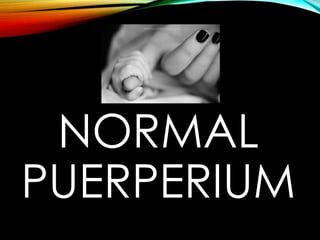
Normal Puerperium: Involution Process and Management
- 2. WHAT IS PUERPERIUM? Period following childbirth Pelvic organs & other body tissues Revert to pre-pregnant state Anatomically & physiologically
- 3. Begins as soon as placenta is expelled lasts for appx 6 weeks(42 days) 3 stages I. Immediate-within 24hrs II. Early -upto 7 days III. Remote – upto 6wks
- 4. INVOLUTION OF THE UTERUS Anatomical consideration ● At delivery-20 x 12 x 7.5cm and appox. 1000g ● After involution-reverted to non-preg size of appox. 60g ● Lower uterine segment isthmus in a few weeks ● Contour of cervix regained in 6 wks ● External os never reverts back to nulliparous state
- 6. Physiological Consideration Muscles: Endometrium: regen starts on day 7 from uterine gland mouths and interglandular stromal cells completed by day 16 except @ placental site Steroid hormones withdrawn Inc Collagenase & Proteolytic enzymes Autolysis Myometrial cell size reduced Endophlebitis Thrombosis Fibrinoid end arteritis Hyalinisation Blood Vessels
- 7. Clinical assessment of Involution of uterus • Fundus lies 13.5cm above sypmphysis pubis for the 1st 24hrs following delivery • Steady decrease by 0.5'' in nxt 24 hrs • Day 14- not palpable- pelvic organ • Completed by 6 wks
- 8. Vagina 4-8 weeks; Does not revert to original state Broad/round ligaments Long time d/t stretching during parturition Pelvicfloor&Fascia Long time d/t stretching during parturition Involution of other Pelvic structures
- 9. LOCHIA • Vaginal discharge for the 1st fortnight during puerperium ● Odour: offensive fishy smell ● Colour and composition Lochia Rubra Lochi Serosa Lochia Alba •1-4 days •Blood,fetal memb & decidua shreds,lanugo,meconium •5-6 days •Leucocytes,Cx mucus,wound exudates,microorganisms •10-15 days •Decicual cells,leucocytes,mucus,cholestrin crystals,fatty epithelial cells,microorganisms
- 10. •Puerperal Sepsis dt E. ColiMalodorous •Infection •Lochiometra Scanty/absent •InfectionExcessive •Subinvolution •Retained conceptus •Causes secondary PPH Red color persist •Local genital infectionL.Alba beyond 3 wks Clinical importance
- 11. CHANGES IN BREAST & LACTATION
- 12. General Physiological Changes Pulse: raises but settles down to normal on 2nd day Temperature: Any rise above 0.5C suggestive of infection of genito-urinary tract Urinary Tract: Pronounced Diuresis on 2nd - 3rd day over distension incomplete emptying presence of residual urine high risk of infection GIT: increased thirst constipation Weight Loss: 5-6kg expulsion of fetus placenta, liqour, blood 2kg- during puerperium dt diuresis Continued upto 6 months of delivery
- 13. Blood Values: immediate-reduced blood volume; Normal in 2 weeks rise in cardiac output; Normal in 1 week leuycocyotsis dt stress Hypercoagulable state for 48 hrs Fibrinolytic activity enhanced in 4 days Menstruation: if not breast feeding- resumes in 6 to 8 wks Ovulation: non-lactating mother- 4 wks lactating mother- 10 weeks Exclusive Breastfeeding- 98% contraception up 6 months
- 14. Management of normal Puerperium To restore health of Mother Rest and Early ambulation Emotional support Diet of patients choice Sleep Immunization- anti-D- Gamma globulin Maternal-infant Bonding Postnatal exercise
- 15. To prevent infection Care of bladder & Vulva Care of episiotomy wound Maintenance of asepsis and proper hygiene Immunization- Rubella vaccine, TT To take care of the Breasts & promote breast feeding To motivate mother for contraception
- 16. • After pains • Uterus massage • Ibuprofen • Anti-spasmodic • Pain at site of perineum • Sitz bath • analgesics • Treatment of Anaemia • Supplementary Iron therapy Treatment of minor ailments
- 17. Abnormal Puerperium Puerperal fever/ pyrexia Puerperal Sepsis • Pelvic pain • Fever • Foul smelling vaginal discharge • Subinvolution
- 18. Breast Problems • Retracted/cracked nipples • Breast engorgement • Mastitis • Breast abscess • Failure of lactation
- 19. Urinary Problems • Retention • Incontinence • Infection Venous thrombosis Secondary Hemorrhage Puerperal psychosis Obstetric palsy
- 20. THANQ
